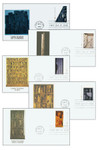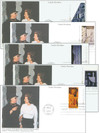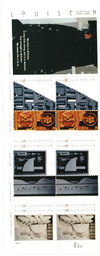
# 3379-83 - 2000 33c Louise Nevelson
2000 33¢ Louise Nevelson
City: New York, NY
Quantity: 55,000,000
Printed By: Ashton-Potter (USA) Ltd
Printing Method: Lithographed
Perforations: 11 x 11 ¼
Color: Multicolored
Birth Of Louise Nevelson

Sculptor Louise Nevelson was born Leah Berliawsky on September 23, 1899, in Pereiaslav, Poltava Governorate, Russian Empire.
Nevelson’s father moved to the United States in the hopes of creating a better life for his family in 1902. After spending some time in Kiev, Nevelson, her mother, and her siblings, joined her father in Rockland, Maine in 1905. There, her father worked as a lumberjack before opening a successful lumberyard. Because of this, the family often had a great deal of wood around the house, and it would later figure prominently in her art.

Nevelson first took an interest in art when she was nine and saw a plaster cast of Joan of Arc at the library. After that, she began taking art classes. Once she graduated from high school, she found work as a stenographer at a law office and met and married Charles Nevelson. The couple then moved to New York City, where Nevelson studied painting, drawing, singing, acting, and dancing. Nevelson’s in-laws disapproved of her studies, with Nevelson once saying, “Within that circle you could know Beethoven, but God forbid if you were Beethoven.” When her husband moved the family to Mount Vernon in 1924, Nevelson missed the artistic environment of the city. They separated at the end of 1932 and eventually got divorced.

Nevelson began studying art full-time at the Art Students League. In 1931 she went to Europe to study in Munich, Italy, and France. After returning to the US, Nevelson experimented with lithography and etching, but decided to commit herself to sculpture. Many of her early pieces were made of plaster, clay, and tattistone. Between 1935 and 1939, she participated in the Works Progress Administration’s painting and sculpture divisions.

In 1936, Nevelson won her first award for sculpture, and in 1941, she had her first solo exhibition. During the 1940s, she produced sculptures inspired by both Cubism and Surrealism, working in stone, bronze, terra cotta, and wood. She struggled financially but was determined to get noticed, so she exhibited her work at every gallery that asked in the 1940s and ’50s. While she won some awards and received praise from art critics, she didn’t get the wide-spread attention she needed to make a good living to support herself and her son. She began teaching sculpture to help pay the bills.

By the mid-1950s, Nevelson’s sculptures began growing to monumental sizes. When the street lived on was slated for demolition and redevelopment, she began collecting scrap materials left behind by her neighbors for her massive artworks. Then in 1955, she participated in a series of shows at the Grand Central Modern Gallery in Manhattan that earned her wider recognition and acclaim. Soon, she was president of the New York Chapter of Artists’ Equality, and had joined a prestigious gallery that enabled her to earn a steady income. She even appeared on the cover of Life magazine.

Nevelson’s sculptures were influenced by her childhood in Maine and her experiences in New York City. She prowled the streets of Manhattan in search of discarded packing materials, boxes, crates, and scraps of wood and metal to transform into her own distinct works of art. Chair legs, broom handles, and cabinet doors often found their way into her pieces. Expansive, three-dimensional walls of wood painted black, white, or gold became trademarks of Nevelson’s style of artwork.

Nevelson had her first one-woman show in Europe in 1960 and sold her first piece to a museum in 1962. That year she also received a six-week fellowship at the Tamarind Lithography Workshop in California. She produced 26 lithographs, the most of any artist in that fellowship up to that time. She created a series of lithographs using unusual materials such as cheese cloth and lace to make interesting textures. This experience provided her with renewed inspiration that she poured into her sculptures. In 1969, she received her first commission for an outdoor sculpture at Princeton University. It was the first of many and she greatly enjoyed creating them. She produced a number of other public works, including the chapel at St. Peter’s Lutheran Church in Manhattan and a wooden sculpture for the US Courthouse in Philadelphia. She also created a piece for the Port Authority of New York and New Jersey in 1978 called Sky Gate. It hung in the lobby of the World Trade Center’s North Tower until its destruction on 9/11.
Nevelson died on April 17, 1988. In New York City, a sculpture garden displays her work at Louise Nevelson Plaza. Her work can also be found in a number public spaces and museums around the country.
Click here to see some of Nevelson’s art.
2000 33¢ Louise Nevelson
City: New York, NY
Quantity: 55,000,000
Printed By: Ashton-Potter (USA) Ltd
Printing Method: Lithographed
Perforations: 11 x 11 ¼
Color: Multicolored
Birth Of Louise Nevelson

Sculptor Louise Nevelson was born Leah Berliawsky on September 23, 1899, in Pereiaslav, Poltava Governorate, Russian Empire.
Nevelson’s father moved to the United States in the hopes of creating a better life for his family in 1902. After spending some time in Kiev, Nevelson, her mother, and her siblings, joined her father in Rockland, Maine in 1905. There, her father worked as a lumberjack before opening a successful lumberyard. Because of this, the family often had a great deal of wood around the house, and it would later figure prominently in her art.

Nevelson first took an interest in art when she was nine and saw a plaster cast of Joan of Arc at the library. After that, she began taking art classes. Once she graduated from high school, she found work as a stenographer at a law office and met and married Charles Nevelson. The couple then moved to New York City, where Nevelson studied painting, drawing, singing, acting, and dancing. Nevelson’s in-laws disapproved of her studies, with Nevelson once saying, “Within that circle you could know Beethoven, but God forbid if you were Beethoven.” When her husband moved the family to Mount Vernon in 1924, Nevelson missed the artistic environment of the city. They separated at the end of 1932 and eventually got divorced.

Nevelson began studying art full-time at the Art Students League. In 1931 she went to Europe to study in Munich, Italy, and France. After returning to the US, Nevelson experimented with lithography and etching, but decided to commit herself to sculpture. Many of her early pieces were made of plaster, clay, and tattistone. Between 1935 and 1939, she participated in the Works Progress Administration’s painting and sculpture divisions.

In 1936, Nevelson won her first award for sculpture, and in 1941, she had her first solo exhibition. During the 1940s, she produced sculptures inspired by both Cubism and Surrealism, working in stone, bronze, terra cotta, and wood. She struggled financially but was determined to get noticed, so she exhibited her work at every gallery that asked in the 1940s and ’50s. While she won some awards and received praise from art critics, she didn’t get the wide-spread attention she needed to make a good living to support herself and her son. She began teaching sculpture to help pay the bills.

By the mid-1950s, Nevelson’s sculptures began growing to monumental sizes. When the street lived on was slated for demolition and redevelopment, she began collecting scrap materials left behind by her neighbors for her massive artworks. Then in 1955, she participated in a series of shows at the Grand Central Modern Gallery in Manhattan that earned her wider recognition and acclaim. Soon, she was president of the New York Chapter of Artists’ Equality, and had joined a prestigious gallery that enabled her to earn a steady income. She even appeared on the cover of Life magazine.

Nevelson’s sculptures were influenced by her childhood in Maine and her experiences in New York City. She prowled the streets of Manhattan in search of discarded packing materials, boxes, crates, and scraps of wood and metal to transform into her own distinct works of art. Chair legs, broom handles, and cabinet doors often found their way into her pieces. Expansive, three-dimensional walls of wood painted black, white, or gold became trademarks of Nevelson’s style of artwork.

Nevelson had her first one-woman show in Europe in 1960 and sold her first piece to a museum in 1962. That year she also received a six-week fellowship at the Tamarind Lithography Workshop in California. She produced 26 lithographs, the most of any artist in that fellowship up to that time. She created a series of lithographs using unusual materials such as cheese cloth and lace to make interesting textures. This experience provided her with renewed inspiration that she poured into her sculptures. In 1969, she received her first commission for an outdoor sculpture at Princeton University. It was the first of many and she greatly enjoyed creating them. She produced a number of other public works, including the chapel at St. Peter’s Lutheran Church in Manhattan and a wooden sculpture for the US Courthouse in Philadelphia. She also created a piece for the Port Authority of New York and New Jersey in 1978 called Sky Gate. It hung in the lobby of the World Trade Center’s North Tower until its destruction on 9/11.
Nevelson died on April 17, 1988. In New York City, a sculpture garden displays her work at Louise Nevelson Plaza. Her work can also be found in a number public spaces and museums around the country.
Click here to see some of Nevelson’s art.




















